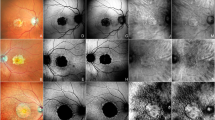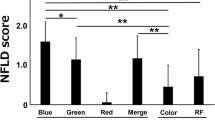Abstract
Aim
To study the diagnostic potential of retro-mode scanning laser ophthalmoscopy (RM-SLO) for evaluation of peripheral retinal lesions.
Methods
Based on the results of indirect ophthalmoscopy, in this study, we included asymptomatic subjects with lattice retinal degeneration, retinal break, or subclinical retinal detachment and subjects without any peripheral retinal lesions. All participants’ fundus periphery was examined with RM-SLO over 360° for the presence of peripheral retinal lesions in a masked fashion. Detection rate for retinal breaks and detachments were compared between indirect ophthalmoscopy and RM-SLO.
Results
Twenty-six subjects (52 eyes, 15 males and 11 females, 34.8 ± 11.8 years) were included in the peripheral retinal lesion group and 25 individuals (50 eyes, 10 males and 15 females, 42.8 ± 14.5 years) were included in the group without peripheral retinal lesions. Among the patients with peripheral retinal lesions detected with indirect ophthalmoscopy in at least one eye, RM-SLO categorized 20.7% (p = 0.031) more eyes as having subclinical asymptomatic retinal detachment or at least one retinal break. Additionally, RM-SLO demonstrated 55.0% (p = 0.001) more subclinical retinal detachments and 31.5% (p = 0.002) more asymptomatic retinal breaks.
Conclusions
RM-SLO showed high potential in diagnosing peripheral retinal lesions and may be a useful additional diagnostic tool for the patients who demonstrate peripheral retinal lesions with indirect ophthalmoscopy.





Similar content being viewed by others
References
Ghazi NG, Green WR (2002) Pathology and pathogenesis of retinal detachment. Eye 16:411–421
Mastropasqua L, Carpineto P, Ciancaglini M, Falconio G, Gallenga PE (1999) Treatment of retinal tears and lattice degenerations in fellow eyes in high risk patients suffering retinal detachment: a prospective study. Br J Ophthalmol 83:1046–1049
Davis MD (1974) Natural history of retinal breaks without detachment. Arch Opthalmol 92:183–194
Boiko EV, Maltsev DS (2016) Retro-mode scanning laser ophthalmoscopy planning for navigated macular laser photocoagulation in macular edema. J Ophthalmol 2016:3726353
Shin YU, Lee BR (2012) Retro-mode imaging for retinal pigment epithelium alterations in central serous chorioretinopathy. Am J Ophthalmol 154:155–163.e4
Maltsev DS, Kulikov AN, Burnasheva MA, Arsenov NV, Chhablani J (2020) Axial length as a basic anatomical predictor for morphological and clinical characteristics in acute central serous chorioretinopathy. Eye (Lond).
Yamamoto M, Mizukami S, Tsujikawa A, Miyoshi N, Yoshimura N (2010) Visualization of cystoid macular oedema using a scanning laser ophthalmoscope in the retro-mode. Clin Experiment Ophthalmol 38:27–36
Katome T, Mitamura Y, Nagasawa T, Eguchi H, Naito T (2012) Scanning laser ophthalmoscope retro-mode imaging of foveal schisis in eyes with X-linked retinoschisis. Clin Exp Ophthalmol 40:e120–e122
Zhang T, Zuo Y, Wei Y, Huang W, Zhou X, Liu R, Zhong L, Peng M, Zhang S (2018) The prevalence and associations of peripheral retinopathy: baseline study of Guangzhou Office Computer Workers. J Ophthalmol 2018:2358690
Mitry D, Charteris DG, Fleck BW, Campbell H, Singh J (2010) The epidemiology of rhegmatogenous retinal detachment: geographical variation and clinical associations. Br J Ophthalmol 94:678–684
Flaxel CJ, Choi YH, Sheety M, Oeinck SC, Lee JY, McDonnell PJ (2004) Proposed mechanism for retinal tears after LASIK: an experimental model. Ophthalmology 111:24–27
Arevalo JF, Lasave AF, Torres F, Suarez E (2012) Rhegmatogenous retinal detachment after LASIK for myopia of up to -10 diopters: 10 years of follow-up. Graefes Arch Clin Exp Ophthalmol 250:963–970
Clark A, Morlet N, Ng JQ, Preen DB, Semmens JB (2012) Risk for retinal detachment after phacoemulsification: a whole-population study of cataract surgery outcomes. Arch Ophthalmol 130:882–888
Ghasemi Falavarjani K, Tsui I, Sadda SR (2017) Ultra-wide-field imaging in diabetic retinopathy. Vision Res 139:187–190
Author information
Authors and Affiliations
Corresponding author
Ethics declarations
Conflict of interest
The authors declare that they have no conflict of interest.
Ethical approval
All procedures performed in studies involving human participants were in accordance with the ethical standards of the institutional and/or national research committee and with the 1964 Helsinki declaration and its later amendments or comparable ethical standards.
Informed consent
Informed consent was obtained for all participants.
Additional information
Publisher’s note
Springer Nature remains neutral with regard to jurisdictional claims in published maps and institutional affiliations.
Rights and permissions
About this article
Cite this article
Maltsev, D.S., Kulikov, A.N., Burnasheva, M.A. et al. Retro-mode scanning laser ophthalmoscopy in evaluation of peripheral retinal lesions. Graefes Arch Clin Exp Ophthalmol 259, 301–306 (2021). https://doi.org/10.1007/s00417-020-04872-9
Received:
Revised:
Accepted:
Published:
Issue Date:
DOI: https://doi.org/10.1007/s00417-020-04872-9




